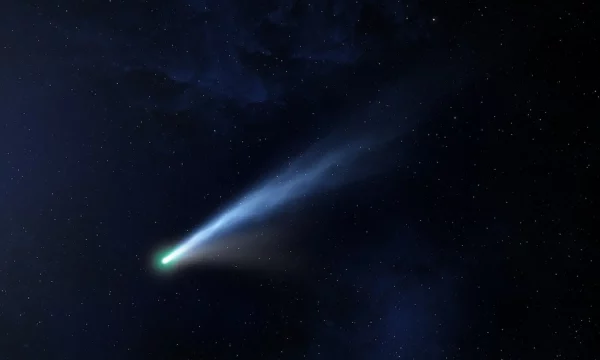
Comet C/2023 A3: The Night Sky's Next Big Event?
Last Updated: August 29, 2023
C/2023 A3 (Tsuchinshan–ATLAS) is a remarkable comet hailing from the Oort cloud, a distant spherical shell of icy bodies enveloping our solar system. This celestial traveler was first discovered by the Asteroid Terrestrial-impact Last Alert System (ATLAS) in South Africa on February 22, 2023.
The comet follows a retrograde orbit with an inclination of 139 degrees, meaning it orbits in the opposite direction to the planets of the solar system. Its closest approach to Earth will be on October 12, 2024, at a distance of 0.47 AU which is much closer than Comet C/2022 E3 ZTF. While its trajectory is weakly bound to the Sun, the comet may potentially be ejected from the solar system after its visit, a fate that remains uncertain at this point.
According to astronomers’ estimates, the comet’s brightness could reach as low as magnitude -0.2, making it one of the brightest objects in the sky.
However, the comet’s brightness is unpredictable, and it could potentially be ripped apart before it reaches its rendezvous with the Sun. Let’s hope it does not! Set to (maybe) illuminate our skies in 2024, Comet C/2023 A3 (Tsuchinshan–ATLAS) brings a sense of anticipation and excitement to astronomers and skywatchers around the world
Comet C/2023 A3's Journey Through the Solar System: A Month-by-Month Guide
January 1st, 2024
Comet C/2023 A3 has passed the orbits of Saturn and Jupiter and is now about 80% of the way to Mars’s orbit. The comet will be approximately 709 million kilometers (440 million miles / 4.73 AU) from Earth.
February 1st, 2024
C/2023 A3 continues its journey between the orbits of Jupiter and Mars. The comet will be 577.63 million kilometers (359 million miles / 3.86 AU) from Earth.
March 1st, 2024
For the second month, C/2023 A3 remains in transit between Jupiter and Mars’s orbits. The comet will be 451.21 million kilometers (280 million miles / 3.02 AU) from Earth.
April 1st, 2024
In its third month traveling between Jupiter and Mars’s orbits, C/2023 A3 will be 334.65 million kilometers (208 million miles / 2.24 AU) from Earth.
May 1st, 2024
For the fourth consecutive month, C/2023 A3 continues its journey between Jupiter and Mars’s orbits. The comet will be 271.19 million kilometers (168 million miles / 1.81 AU) from Earth.
June 1st, 2024
In its fifth consecutive month between Jupiter and Mars’s orbits, C/2023 A3 will be 270.32 million kilometers (168 million miles / 1.81 AU) from Earth.
July 1st, 2024
For the sixth consecutive month, C/2023 A3 remains in transit between Jupiter and Mars’s orbits, almost there! The comet will be 296.66 million kilometers (184 million miles / 1.98 AU) from Earth.
August 1st, 2024
C/2023 A3 finally reaches the area between Earth and Mars, descending through the solar system plane towards its orbital perihelion. The comet will be 305.66 million kilometers (190 million miles / 2.04 AU) from Earth.
September 1st, 2024
C/2023 A3 is entering Venus’s orbit and will begin to experience higher temperatures emanating from the Sun. The next few weeks are critical for C/2023 A3 as it faces the risk of disintegration. We all hope it remains intact for a spectacular display in two months. The comet will be 261.40 million kilometers (162 million miles / 1.75 AU) from Earth.
October 1st, 2024
C/2023 A3 reached its perihelion a few weeks ago, and if it has survived its close encounter with the Sun, it is now ascending in its orbit. The comet will be 115.29 million kilometers (71.6 million miles / 0.77 AU) away from Earth. On October 12th, the comet will be at its closest position to Earth, presenting the best opportunity for stargazers to observe it with binoculars and telescopes. Expect a flurry of pictures on social media, and we can’t wait to see them!
November 1st, 2024
Having gained speed during its perihelion (67km per seconds), the comet is now leaving the solar system faster than it entered. Its brightness in the night sky has faded as it travels outward from the inner planets. The comet will be 147.25 million kilometers (91.5 million miles / 0.98 AU) from Earth.
December 1st, 2024
C/2023 A3 is well on its way towards the orbits of the outer planets. Fun fact: it will take the comet another 20 years to exit the solar system, moving beyond Neptune’s orbit. At this point, the comet will be 293.67 million kilometers (182.4 million miles / 1.96 AU) away from Earth. It will not return to the solar system for another 26,000 years.
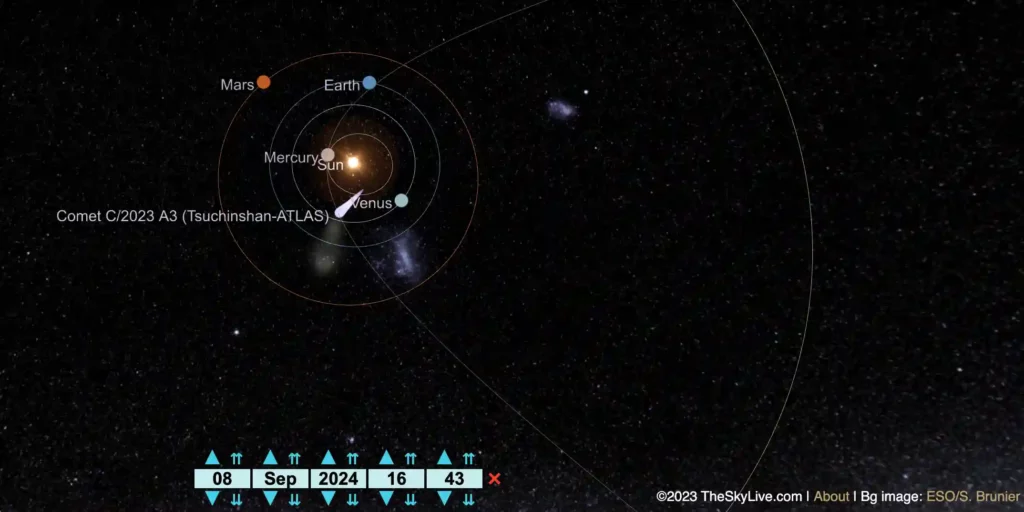
Comet C/2023 A3's Journey through the northern night sky: A Month-by-Month Guide
This guide is based on comet C/2023 A3’s ephemeris data from Los Angeles. For more accurate data based on your precise location, especially for our friends in the southern hemisphere, I suggest using a stargazing application such as Stellarium.
January 1st, 2024
Comet C/2023 A3 will be located within the Libra constellation with an apparent magnitude of 15.23. The comet will be visible from 4:22 AM to 5:52 AM. The object will be located at 15h01m38s right ascension and -07°20’58” declination.
Visibility rating: Very poor
February 1st, 2024
Comet C/2023 A3 will be located within the Libra constellation and have an apparent magnitude of 14.45. The comet will be visible from 02:32 AM until 05:46 AM. The object will be located at 15h10m42s right ascension and -07°53’57” declination.
Visibility rating: Very poor
March 1st, 2024
Comet C/2023 A3 will remain in the Libra constellation with an apparent magnitude of 13.57. The comet will be visible from 00:30 AM until 05:19 AM. The object will be located at 15h05m18s right ascension and -07°18’06” declination.
Visibility rating: Very poor
April 1st, 2024
Comet C/2023 A3 will transition to the Virgo constellation and have an apparent magnitude of 12.50. The comet will be visible from 22:45 PM until 05:37 AM. The object will be located at 14h30m46s right ascension and -04°52’25” declination.
Visibility rating: Very poor
May 1st, 2024
Comet C/2023 A3 will remain within the Virgo constellation with an apparent magnitude of 11.55. The comet will be visible from 20:41 PM until 03:40 AM. The object will be located at 13h20m02s right ascension and -00°41’21” declination.
Visibility rating: Very poor
June 1st, 2024
Comet C/2023 A3 will still be located within the Virgo constellation with an apparent magnitude of 10.91. The comet will be visible from 21:09 PM until 00:29 AM. Look to the south, southwest, towards the head of Virgo. The object will be located at 12h00m29s right ascension and +02°38’54” declination.
Visibility rating: Very poor
July 1st, 2024
Comet C/2023 A3 will transition to the Leo constellation with an apparent magnitude of 10.31. The comet will not be visible at all from this location. Look toward the western night sky, right between Virgo and Leo. It’s going to be a very short viewing window. The comet will be visible from 21:34 PM until 23:12 PM. The object will be located at 11h15m09s right ascension and +02°43’59” declination.
Visibility rating: Very poor
August 1st, 2024
Comet C/2023 A3 will remain within the Leo constellation with an apparent magnitude of 9.19. During this month, observing this comet from the northern hemisphere will be very difficult. Its path in the sky follows very closely the Sun’s path so it rises and sets pretty much at the same time.
Visibility rating: Extremely poor
September 1st, 2024
Comet C/2023 A3 will be located within the Sextans constellation with an apparent magnitude of 6. During this month, observing this comet from the northern hemisphere will be very difficult. Its path in the sky follows very closely the Sun’s path so it rises and sets pretty much at the same time.
Visibility rating: Extremely poor
October 1st, 2024
Comet C/2023 A3 will return to the Leo constellation with an apparent magnitude of 2.55. Expect it to be difficult to observe the comet during the first 10 days in October as it is completing its close encounter with the Sun from our perspective on Earth.
On the 12th of October, during its closest approach to the Sun, the comet will be located in the Virgo constellation, with an apparent magnitude of -0.2. Look towards the western sky and you will find it at the following celestial coordinates: 14h 11m55.3s -01°03’08.7 from 6.45 pm until 7.30 pm.
Visibility rating: Good, but short observing windows. Be prepared!
November 1st, 2024
Comet C/2023 A3 will be located within the Ophiuchus constellation with an apparent magnitude of 6.17. The comet will be visible from 18:59 PM until 20:41 AM. The object will be located at 18h03m56s right ascension and +03°47’26” declination. Its brightness is decreasing rather quickly at this point, it will become a telescope-only object and then fade into the darkness of space again.
Visibility rating: Good in the early November days but soon after it will be very difficult to see
December 1st, 2024
Comet C/2023 A3 will be located within the Aquila constellation with an apparent magnitude of 9.39. At this point, I don’t expect any amateur will be able to catch a glimpse of the comet except those with high-end refracting telescopes. But even then, the grand show is now over so there would be very little excitement in trying to observe it. The comet is now on its way out of the solar system, into the depth of outer space. See you in 26,000 years!
Visibility rating: Very poor
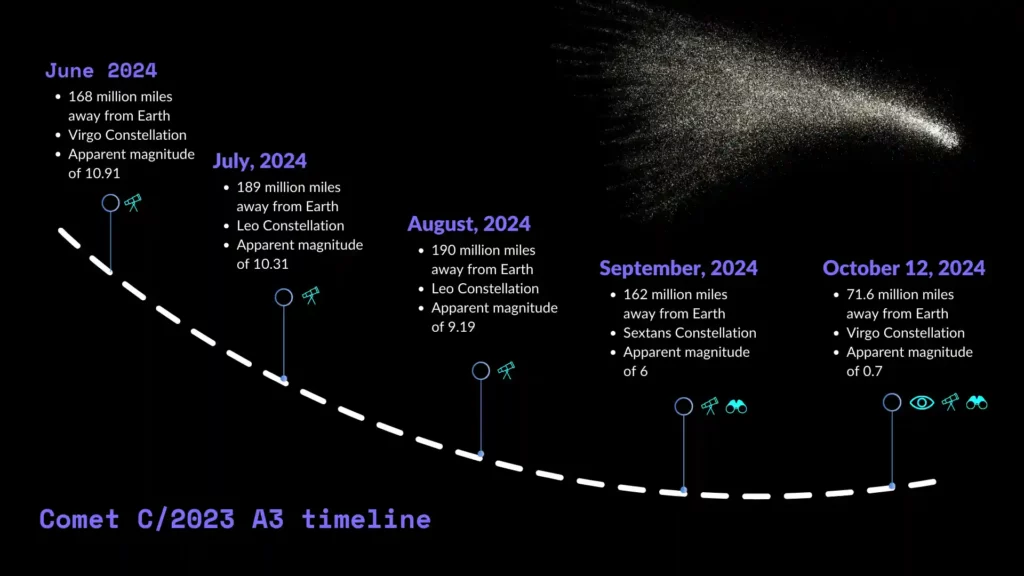
How bright will comet C/2023 A3 become?
According to astronomers’ estimates, the newly discovered comet, C/2023 A3 (Tsuchinshan-ATLAS), could reach a brightness of magnitude 0.7 at its closest approach to the Sun. In comparison, for comparison C/2020 F3 NEOWISE was magnitude 7, C/2022 E3 was magnitude 5, and Hyakutake was 0. As for the infamous 1997 comet Hale-Bopp, it might keep its record of the brightest comet in history with an apparent magnitude of -1.8.
At its closest point to Earth, the comet’s magnitude could reach -0.2, which is brighter than some of the brightest stars in the night sky, namely Arcturus (4th) and Vega (5th).
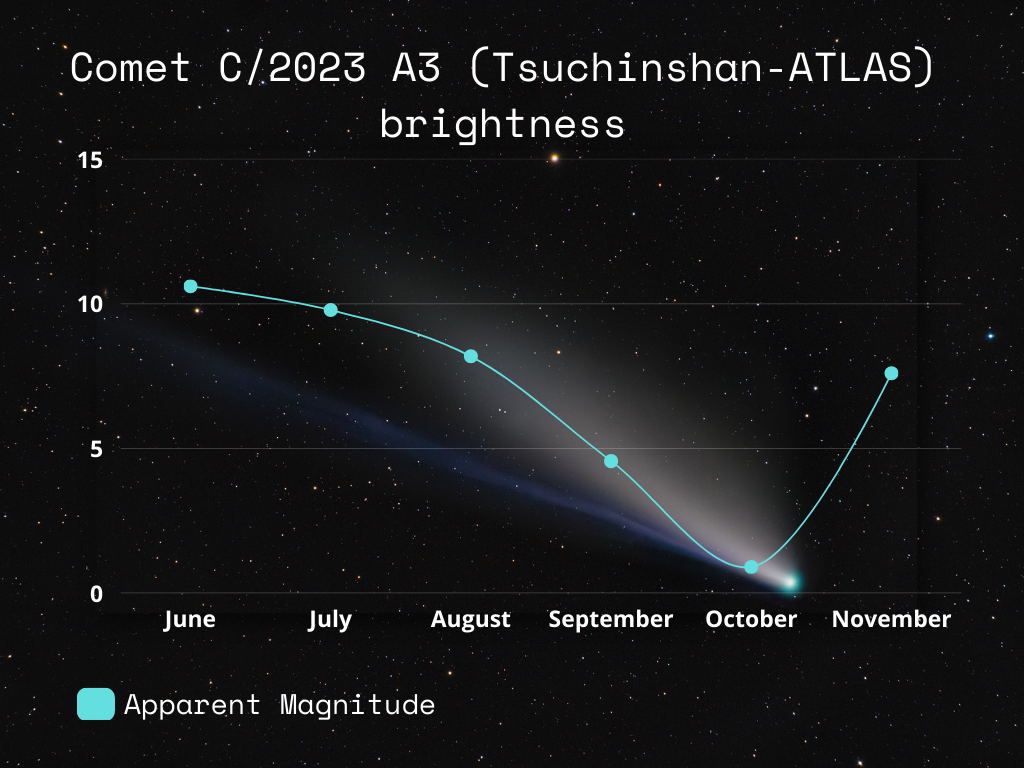
Where can you find the comet when it's at perihelion?
At perihelion, Comet C/2023 A3 (Tsuchinshan-ATLAS) will be positioned at a right ascension of 14h05m10s and a declination of 1°03’S. It will be located within the Virgo constellation and have an apparent magnitude of 0.7.
Look towards the western sky starting from 19:05 PM and for about an hour and 30 mins. Each passing night the comet will be visible 5/10 minutes earlier and stay visible for an extra 15/20 minutes.
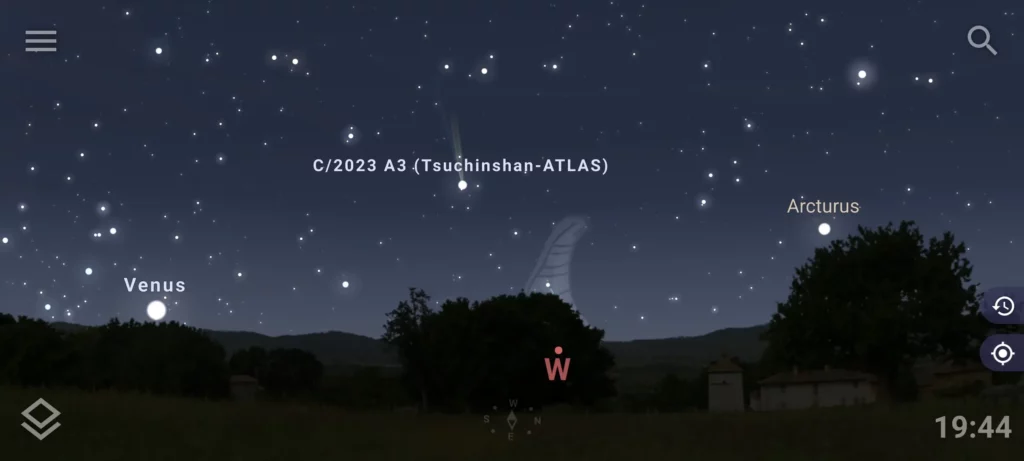
How to prepare your observation of Comet C/2023 A3 (Tsuchinshan-ATLAS)
When it comes to chasing comets, the most important thing is sufficient planning. If and when Comet C/2023 A3 shows up, it seems like it will not be visible for long stretches of time. So you need to prepare your observation precisely and make sure you know when and where to be.
When it comes to stargazing planning, my favourite tool is Stellarium. It’s a stargazing app that allows you to see the night sky and the live position of any celestial objects in real time. What’s better is that the app also allows you to see the night sky for past and future dates.
Here’s a step-by-step guide on how to prepare your observation of a comet using the Stellarium Web app:
- Open your web browser and go to the Stellarium Web app at https://stellarium-web.org/
The app will ask for permission to access your location. Granting permission will help the app provide accurate information based on your location. Alternatively, you can manually input your location using the search bar on the lower left corner. - In the search bar at the top left corner of the screen, type the name or designation of the comet you want to observe (e.g., “Comet C/2023 A3”) and press Enter.
- If the comet is in the Stellarium database, it should appear in the search results. Click on the comet’s name to center it on the screen.
- The app will display information about the comet, such as its current position, altitude, and magnitude, in the top-left corner.
- To view the comet at a specific date and time, click on the “Date and Time” button (clock icon) in the bottom right corner. Adjust the date and time sliders to your desired observation time, then click “Apply.”
- The app will update the view to show the position of the comet at the selected date and time.
- Look for any important information, such as the rise, transit, and set times of the comet, displayed in the top-left corner. This will help you determine the best time to observe the comet.
- Use the app to familiarize yourself with the surrounding stars and constellations to help you locate the comet when you go outside for your observation.
With this information, you should be well-prepared to observe the comet in the night sky. Remember to choose a dark location away from city lights and give your eyes time to adjust to the darkness for the best viewing experience.
How does Comet C/2023 A3 compare to the most famous comets?
Over the last 50 years, several famous comets have captured the attention of stargazers worldwide. Notable examples include the historic Halley’s Comet (1986), which appears every 76 years; Comet Hyakutake (1996), known for its close approach to Earth and bright blue ion tail; Comet Hale-Bopp (1997), visible to the naked eye for a record-breaking 18 months; and Comet NEOWISE (2020), which offered a stunning display in the night sky during July 2020.
How will Comet C/2023 A3 hold up against these famous comets? It’s too early to say but it is safe to say that we all can not wait to find out!



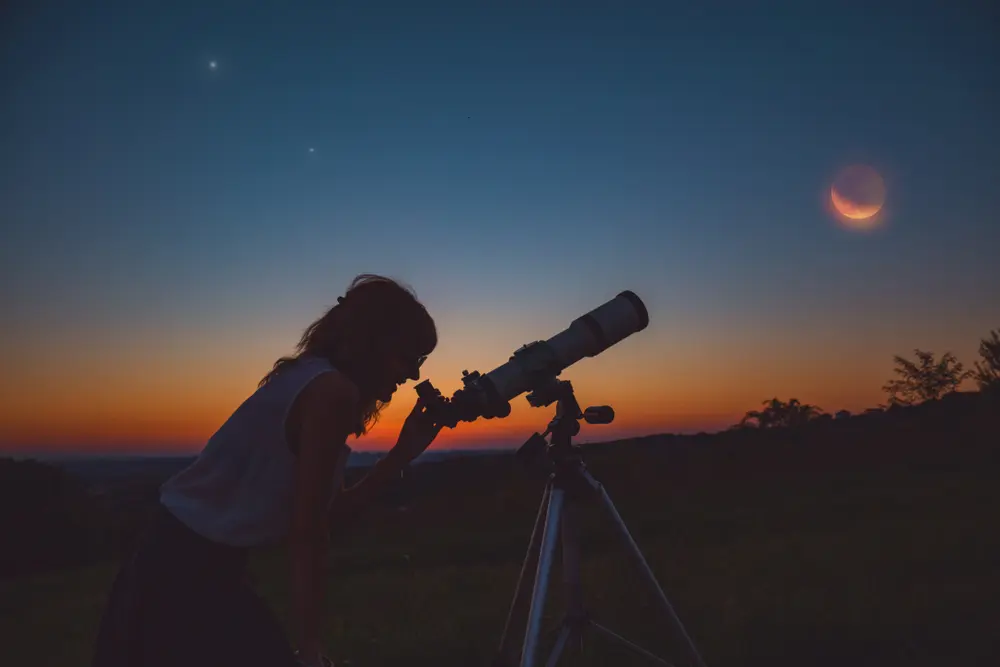

There are many beautiful objects in the night sky including stars and planets. But, which planets are the brightest in the night sky?
